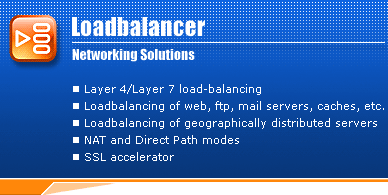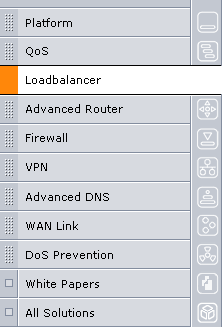|
LOADBALANCING AT LAYER 7 AND SSL ACCELERATION
  |
SysMaster Layer 7 Loadbalancing
Features |
 |
 |
 |
- URL switching. Distributes traffic based on URL prefix, suffix,
random segment or full match. Allows for flexible online content
deployment.
- URL switching with cookie persistence. Distributes traffic as
part of the HTTP URL switching with persistence.
- URL Hashing. Facilitates balanced distribution of content across
array of proxy servers and prevents content duplication.
- Cookie Persistence. Implements persistence to real servers through
HTTP cookies. Also implements cookie hashing.
- SSL Acceleration. Implements centralized SSL connection termination.
  |
Why is Layer 4 Loadbalancing
not always enough? |
 |
 |
 |
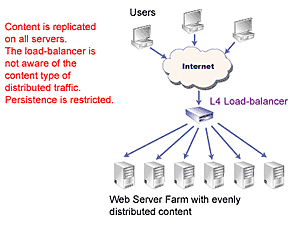
Loadbalancing online traffic at OSI Layer 4 is a
very fast solution for managing servers offering various services
such as E-mail service, Web service, FTP service, DNS service etc.
Each of these services and their corresponding servers can be grouped
and managed separately. The Layer 4, operating at the level of TCP/IP
and UDP protocols, boasts very fast loadbalancing yet it lacks the
flexibility for handling diverse HTTP traffic intelligently. As
a result, persistence across web servers is very limited.
  |
What Layer 7 Loadbalancing
Does |
 |
 |
 |
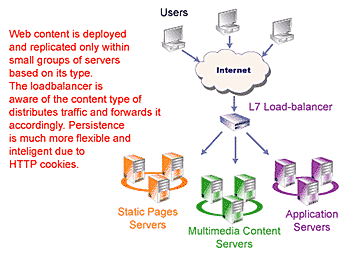
Layer 7 loadbalancing is a feature rich solution
web traffic distribution across web servers. In contrast to Layer
4, loadbalancing at Layer 7 (HTTP) allows for grouping of servers
based on type of content they serve. This facilitates greatly the
ease of managing and updating the served content. In addition, Layer
7 loadbalancing allows for much flexible cookie management and hence
intelligent persistence implementation.
  |
Traffic Loadbalancing Based on
URL Switching |
 |
 |
 |
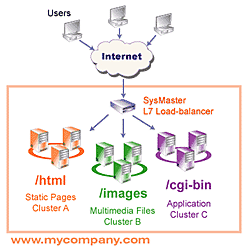 Cluster
A serves the static content of Cluster
A serves the static content of
www.mycompany.com. All requests
to www.mycompany.com/html are
forwarded to Cluster A.
Cluster B serves the multimedia
content. For instance, a request
to www.mycompany.com/images is
forwarded to Cluster B.
Cluster C runs the application logic
of the site. All requests to www.mycompany.com/cgi-bin
is forwarded to Cluster C.
SysMaster uses Weighted Least Connections (WLS) method to balance
traffic within a cluster. Also cookies can be used to implement
persistence within a cluster.
SysMaster uses the following parameters to for URL
switching:
- IP address, TCP/UDP Port
- URL
- Virtual Host name and cookies
With URL switching, network administrators can deploy
hardware that is suitable for serving the appropriate content type.
The content replication is more efficient as the content is replicated
to a relatively small group of servers. Within server groups SysMaster
loadbalances the traffic and can also implement cookie persistence.
URL hashing is added when loadbalancing proxy servers.
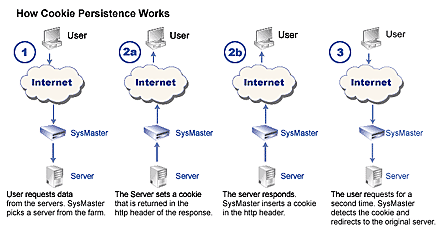
As cookies are part of the HTTP protocol (at Layer
7), SysMaster can read, insert or modify cookies in the HTTP packets
passing through it. SysMaster provides two ways of performing cookie
persistence.
Active
SysMaster inserts a cookie in the HTTP header of the response packet
identifying the server from which the cookie came. When a request
comes from the same client, the cookie indicates what server should
process the request.
Passive
The server inserts a cookie instead SysMaster.
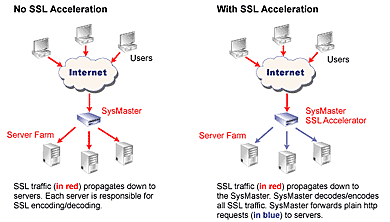
The industry standard protocol SSL provides unbreakable
security for Internet connections. SysMaster provides centralized
processing of the SSL encryption/decryption. The SSL accelerator
offloads the web servers from the CPU intensive task of processing
SSL packets. This frees valuable server resources for serving maximum
number of pages. In addition, with centralized termination of SSL
connections, the management of the whole system is significantly
simplified as the server farm needs only one pair of public and
private key.
|



